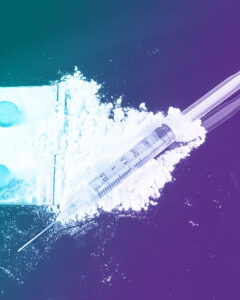What is Heroin Cut With

In Manatee County in 2016, 1,287 opioid-related overdoses were reported, resulting in 123 deaths. This was the highest number of overdoses by county in the state of Florida. Even in 2021, numbers still remain high, with 803 opioid-related overdoses, resulting in 113 deaths. Here at Clean Recovery Centers, we understand that these numbers are stifling, and we are working to provide resources and education within our Suncoast communities. Today, we are discussing what heroin is cut with, and what you need to know to keep yourself safe.
The Different Types of Heroin
Heroin is a depressant, a semi-synthetic opioid derived from morphine. It works in the brain by binding to the opioid receptors, releasing feelings of pleasure and relaxation. The central nervous system is responsible for regulating breathing and heart rate, and heroin works by slowing this system.
Heroin comes in different forms, such as powder or tar. In powder form, heroin is typically white, off-white, or brownish tan. Heroin in the form of a sticky substance that can be moist to the touch is referred to as black tar heroin. Powder forms of heroin are usually snorted or dissolved in liquid for injection, while black tar is typically smoked or injected.
No matter what type is being used, the side effects of heroin can cause discomfort and health problems. When heroin is cut with different substances, these effects can become more serious and even life-threatening.
The Most Common Heroin Cutting Agents
There are different types of cutting agents, classified as diluents and adulterants. Diluents are substances that add volume, while adulterants are added to enhance or extend the effects of the substance.
Some common diluents in heroin include:
- Sugar
- Starch
- Powdered milk
- Talc
- Quinine
- Baking Powder
Some common adulterants include:
- Fentanyl
- Cocaine
- Caffeine
- Acetaminophen
- Rizzy
- Xylazine
 Xylazine is a non-opiate sedative, and has been making its presence known recently. It is only prescribed by a veterinarian and is used as a muscle relaxant in animals. The effects of human use are still being analyzed, but many have described the feeling xylazine creates as similar to opioids. When mixed with fentanyl and heroin, it has been linked to accidental overdoses. Anytime heroin is mixed with a substance that is not regulated for human consumption, the lasting effects of heroin on the body can be devastating.
Xylazine is a non-opiate sedative, and has been making its presence known recently. It is only prescribed by a veterinarian and is used as a muscle relaxant in animals. The effects of human use are still being analyzed, but many have described the feeling xylazine creates as similar to opioids. When mixed with fentanyl and heroin, it has been linked to accidental overdoses. Anytime heroin is mixed with a substance that is not regulated for human consumption, the lasting effects of heroin on the body can be devastating.
“Rizzy” is also another cutting agent circulating with heroin. “Rizzy” is the powder that comes in store-bought flowers, intended to extend their freshness. When mixed with heroin, this powder causes skin lesions that can eventually turn necrotic, especially when left untreated. A study published in 2019 confirmed this connection between IV substance users and skin lesions.
Cutting Heroin with Fentanyl
We have all been seeing news stories about the dangers of fentanyl. This is because fentanyl is one of the most powerful opioids, 50-100 times stronger than morphine. Heroin is already an opioid, meaning it depresses vital body systems to achieve euphoria and relaxation. By adding fentanyl, the brain’s opioid receptors become overwhelmed. Breathing can stop, depriving the body of essential oxygen. This is how a heroin overdose occurs, and if you or a loved one ever suspect an overdose is happening, seek medical attention immediately.
Narcan is the first line of defense in an opioid overdose situation. It is sold over-the-counter at many convenience stores and is also carried by first responders. Narcan works by blocking the opioid receptors to restore breathing and central nervous system functions. If Narcan is used before paramedics arrive, be sure to inform them so they can treat accordingly.
The Difference Between Lacing and Cutting
Cutting and lacing are similar terms, referring to adding other substances to heroin in order to increase the effects and/or create more product to sell. Cutting is the term used most often by dealers, and can mean adding an adulterant or diluent into a substance while lacing is more associated with adding adulterants.
You may be thinking, why would dealers need to add to substances? When it comes to profit, more is always better. Think about going to the grocery store. There are often different sizes of products to buy. Eight ounces of olive oil will be cheaper than 16 ounces, but if you use olive oil a lot, then 16 ounces may be the better deal. Similarly, if a dealer has 8 ounces of heroin and adds in a cheap substance like sugar, he now has 16 ounces of “heroin” to sell.
The same can be said about brands. If a brand of mac and cheese tastes better, you are more likely to buy it again no matter the price. When adulterants are added to heroin, the effects can be prolonged, making the “high” better. Heroin users will continue to go back to that dealer for the better product.
The Dangers of Cutting Heroin with Other Drugs
Besides heroin cut with fentanyl, a common mixture is cocaine and heroin. This is known as a speedball, and the two substances will counteract each other. Heroin is a depressant while cocaine is a stimulant, meaning each substance affects different systems. This can lead to an increase in use as the “high” may not feel the same or as strong.
Another risk is withdrawal symptoms. Heroin withdrawal is already uncomfortable, and when mixed with other drugs, withdrawal from those can occur also. Symptoms of heroin withdrawal include:
- Yawning
- Mood swings
- Nausea
- Vomiting
- Diarrhea
- Abdominal cramping
- Dilated pupils
- Muscle cramps or twitching
When these symptoms become mixed with withdrawal symptoms of substances like cocaine, mental health takes a serious toll. Increased depression, anxiety, agitation, and hostility can lead to mental breakdowns. If you ever experience thoughts of self-harm, suicide, or harming others, seek medical attention immediately.
Getting Treatment for Heroin Use Disorder
Chances are, you know someone affected by the opioid epidemic. Whether a sibling, parent, friend, or coworker, opioids like heroin have been taking charge of peoples’ lives and well-being in front of our eyes. It is easy to feel powerless, wanting to help but not knowing what to do or how to start the conversation. You search the web trying to find any form of assistance and hope before it’s too late.
Here at Clean Recovery Centers, we hear these stories all the time. We understand how scary it can feel to seek heroin addiction recovery, but we are here to tell you it is the opposite. Being liberated from heroin use disorder and rediscovering your strengths, passions, and relationships will feel more powerful than substance use ever could. Our compassionate staff strives to provide a family-like atmosphere while offering housing in a community of recovering peers. The three-phase program utilized by Clean Recovery Centers is totally unique, and it’s tailored to each individual that walks through our doors.
If you or someone you love is managing life and heroin use, there is hope for a future without heroin. The treatment program at Clean Recovery Centers is suited to address every aspect of addiction – physically, mentally, spiritually, and socially. Call us today at (888) 330-2532 to schedule an appointment.
FAQs
What are the most common cutting agents for heroin?
Some of the most common cutting agents for heroin are powdered milk, talc, baking powder, over-the-counter painkillers, and fentanyl.
What is the difference between cutting and lacing?
While similar terms, cutting usually refers to adding adulterants or diluents to a substance while lacing refers to only adding adulterants.
How long does heroin stay in the body?
Heroin stays in the body for 12-24 hours after the last use.
Sources:
- https://www.heraldtribune.com/story/opinion/editorials/2022/02/28/manatee-county-gets-reality-check-opioid-abuse-and-overdoses/6923154001/
- https://www.dea.gov/sites/default/files/2022-12/The%20Growing%20Threat%20of%20Xylazine%20and%20its%20Mixture%20with%20Illicit%20Drugs.pdf
- https://www.ncbi.nlm.nih.gov/pmc/articles/PMC6666922/


